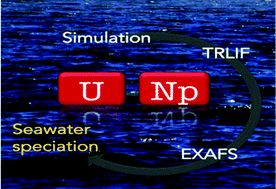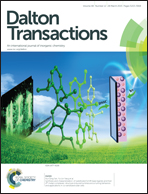XAS and TRLIF spectroscopy of uranium and neptunium in seawater†
Abstract
Seawater contains radionuclides at environmental levels; some are naturally present and others come from anthropogenic nuclear activity. In this report, the molecular speciation in seawater of uranium(VI) and neptunium(V) at a concentration of 5 × 10−5 M has been investigated for the first time using a combination of two spectroscopic techniques: Time-resolved laser-induced fluorescence (TRLIF) for U and extended X-ray absorption fine structure (EXAFS) for U and Np at the LIII edge. In parallel, the theoretical speciation of uranium and neptunium in seawater at the same concentration is also discussed and compared to spectroscopic data. The uranium complex was identified as the neutral carbonato calcic complex UO2(CO3)3Ca2, which has been previously described in other natural systems. In the case of neptunium, the complex identified is mainly a carbonato complex whose exact stoichiometry is more difficult to assess. The knowledge of the actinide molecular speciation and reactivity in seawater is of fundamental interest in the particular case of uranium recovery and more generally regarding the actinide life cycle within the biosphere in the case of accidental release. This is the first report of actinide direct speciation in seawater medium that can complement inventory data.


 Please wait while we load your content...
Please wait while we load your content...